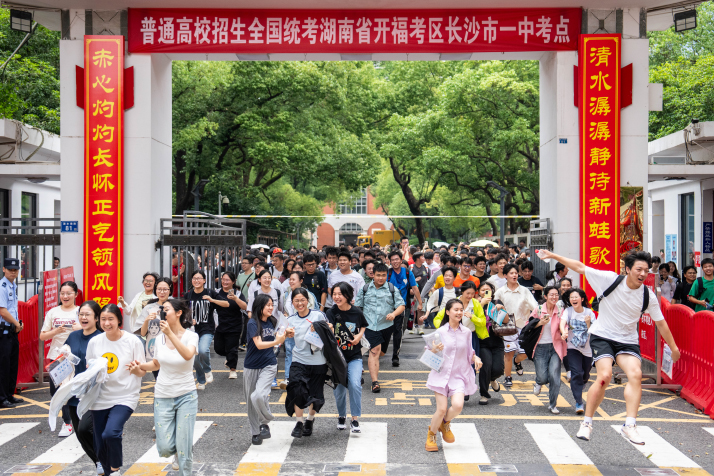| China |
| A turning point in Gaokao? | |
|
|
 On June 7, a student makes the most of her time by reviewing outside the Harbin No.9 High School examination site in Harbin, Heilongjiang Province, before taking the gaokao (XINHUA)
Early June is a tense but pivotal time for many families across China, as it's the time of the annual gaokao, the national college entrance examination. Beginning on June 7, this rigorous exam period typically spans two to four days, depending on the region. For many students, their performance on the gaokao can significantly shape their academic and professional futures for years to come. China's gross enrollment rate in higher education, the ratio of higher education students to the total population aged 18-22, has seen exponential growth, soaring from about 2 percent in 1977—when the exam was reinstated following its suspension during the tumultuous Cultural Revolution (1966-76) period—to more than 60 percent by 2023, according to the latest available data from the Ministry of Education (MOE). However, competition for coveted spots at top-tier universities and colleges remains fierce. On May 28, the MOE revealed that the number of this year's gaokao applicants in China stood at 13.35 million, a decrease of 70,000 from last year, the first drop in eight years. What does this signal about the evolving landscape of education and opportunity in China? The trend in gaokao applicant numbers has been a subject of considerable public attention in recent years. From 2015 to 2017, the number of applicants hovered at around 9.4 million. This figure then rose to 9.75 million in 2018. In 2019, gaokao enrollment surpassed 10 million, reaching 10.31 million. The upward trend continued steadily, with 10.71 million applicants in 2020, 10.78 million in 2021, 11.93 million in 2022, and 12.91 million in 2023. Last year, the number reached a historical peak of 13.42 million. Factors behind the decline One major factor contributing to the decrease in the gaokao applicant numbers this year is a decline in the eligible population. The number of gaokao applicants is closely linked to birth rates 18 years prior. This year's cohort predominantly comprises individuals born in 2006 and 2007, and the dip in applicant numbers corresponds to the number of births during those years. Official data indicate that there were 15.81 million births in 2006 and 15.91 million in 2007—comparatively lower than birth rates in preceding years. Changes in the number of students retaking the exam can also influence overall applicant figures. While the proportion of students retaking the gaokao had been increasing in recent years, the number of repeat test-takers did not significantly rise this year. This is likely due to factors such as the diversification of admission pathways into higher education institutions. Vocational education has garnered unprecedented attention in recent years. The revised Vocational Education Law of 2022 explicitly states, for the first time, that vocational education is of equal importance to general education. It also mandates increased funding for vocational education at all levels of government and strengthens the management of teachers and students to foster a better learning environment. This policy shift may encourage more students to pursue vocational education, consequently reducing the number of gaokao applicants to some extent. The growth of international education may be another influencing factor. In recent years, studying abroad has been a popular option for families with strong financial resources, enabling their children to access international education and experience diverse cultures and pedagogical approaches. This trend diverts a segment of students who might otherwise participate in the gaokao. The proportion of high school graduates choosing to pursue overseas education increased in recent years, particularly in first-tier cities and economically developed coastal areas. According to data from the MOE in 2023, the total number of Chinese students studying abroad exceeded 800,000, a 23-percent increase from 2019.  After completing the gaokao, students run out of the Changsha No.1 High School examination site in Changsha, Hunan Province, on June 9 (XINHUA)
Future trends Does the decline in gaokao enrollment translate to reduced competitive pressure? On the surface, the decrease in the number of gaokao applicants may suggest a decline in overall competitive intensity. Moreover, Zheng Shanjie, head of the National Development and Reform Commission, stated at a press conference in March that the scale of national college enrollment will be further expanded this year, with an increase of 20,000 undergraduate enrollment slots for universities under the Double First-Class initiative, a program designed to enhance higher education quality and global competitiveness. However, Fan Xiudi, Director of the Education Evaluation Center at Tongji University, cautioned in an interview with Shangguan News, a Shanghai-based digital news platform, that the decrease in the national total number of gaokao applicants does not necessarily indicate a decline in applicant numbers across all provincial-level regions. In fact, some provinces and cities have experienced an increase. For example, Fujian Province added 10 new gaokao test centers this year, accommodating an additional 14,000 test-takers compared with last year. Since students are ranked and admitted based on their exam scores within their respective provincial-level region, competition remains intense in some regions. Moreover, competition for popular majors and top-tier institutions is unlikely to diminish as enrollment capacities have not significantly expanded. Finally, while gaokao participant numbers dropped for the first time in eight years this year, this decline may prove to be temporary. China experienced a surge in births following the steady relaxation of its family planning policy in 2013, 2015 and 2021, allowing all couples to have two children and then three children. The number of newborns reached peaks of 17.86 million and 17.23 million in 2016 and 2017, respectively. The birth rate trends suggest that the gaokao participant number is expected to generally exhibit a stably increasing trend over the next decade. BR Copyedited by G.P. Wilson Comments to jijing@cicgamericas.com |
|
||||||||||||||||||||||||||||||
|